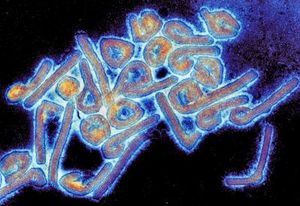Korarchaeum cryptofilum
Introduction
Candidatus Korarchaeum cryptofilum is a species of the proposed phylum Korarchaeota, or Xenarchaeota of the Archaea. The Archean is found mainly in hydrothermal environments such as hot springs, shallow water, and deep ocean. The organism's genome has mainly been studied to open understanding of Archaean evolution.
Select a topic about genetics or evolution in a specific organism or ecosystem.
Select a topic about genetics or evolution in a specific organism or ecosystem.
The topic must include one section about microbes (bacteria, viruses, fungi, or protists). This is easy because all organisms and ecosystems have microbes.
Compose a title for your page.
Type your exact title in the Search window, then press Go. The MicrobeWiki will invite you to create a new page with this title.
Open the BIOL 116 Class 2019 template page in "edit."
Copy ALL the text from the edit window.
Then go to YOUR OWN page; edit tab. PASTE into your own page, and edit.
At right is a sample image insertion. It works for any image uploaded anywhere to MicrobeWiki. The insertion code consists of:
Double brackets: [[
Filename: PHIL_1181_lores.jpg
Thumbnail status: |thumb|
Pixel size: |300px|
Placement on page: |right|
Legend/credit: Electron micrograph of the Ebola Zaire virus. This was the first photo ever taken of the virus, on 10/13/1976. By Dr. F.A. Murphy, now at U.C. Davis, then at the CDC.
Closed double brackets: ]]
Other examples:
Bold
Italic
Subscript: H2O
Superscript: Fe3+
Genetics and Structure
The genome of Ca. K. cryptofilum is 1,590,757 base pairs long with an average G+C content of 49%. The arCOG of the archaean phyla crenarchaeota and euryarchaeota when compared with the sequenced genome of Ca. K. cryptofilum, showed that the organism shares its replication, recombination, repair, and cell division genes with that of crenarchaeota while it shares most of its transcription and translation genes with euryarcahaeota.
[1]
Ca. K. cryptofilum has three rRNA genes (16S, 23S, and 5S rRNA. The organism has shown to produce 33 23S r-proteins and 27 16S r-proteins on its rRNA operon. The species is also found to have 45 tRNA genes on its genome with one initiator and 45 elongator tRNAs.[2]
Sample citations: [3]
[4]
A citation code consists of a hyperlinked reference within "ref" begin and end codes.
Microbiome
Include some current research, with a second image.
Conclusion
Overall text length should be at least 1,000 words (before counting references), with at least 2 images. Include at least 5 references under Reference section.
References
- ↑ > Miller-Coleman, Robin L et al. “Korarchaeota diversity, biogeography, and abundance in Yellowstone and Great Basin hot springs and ecological niche modeling based on machine learning.” PloS one vol. 7,5 (2012): e35964. doi:10.1371/journal.pone.0035964
- ↑ > Miller-Coleman, Robin L et al. “Korarchaeota diversity, biogeography, and abundance in Yellowstone and Great Basin hot springs and ecological niche modeling based on machine learning.” PloS one vol. 7,5 (2012): e35964. doi:10.1371/journal.pone.0035964
- ↑ Hodgkin, J. and Partridge, F.A. "Caenorhabditis elegans meets microsporidia: the nematode killers from Paris." 2008. PLoS Biology 6:2634-2637.
- ↑ Bartlett et al.: Oncolytic viruses as therapeutic cancer vaccines. Molecular Cancer 2013 12:103.
Edited by [Charlie Stutz], student of Joan Slonczewski for BIOL 116 Information in Living Systems, 2019, Kenyon College.
Miller-Coleman, Robin L et al. “Korarchaeota diversity, biogeography, and abundance in Yellowstone and Great Basin hot springs and ecological niche modeling based on machine learning.” PloS one vol. 7,5 (2012): e35964. doi:10.1371/journal.pone.0035964

